The BarBend Guide on How to Start CrossFit
The growing world of CrossFit is only getting bigger as endurance athletes, lifters, and all-around beginners continue turning toward community-based intense workouts to achieve their fitness goals. But CrossFit doesn’t necessarily feel like the easiest thing to jump into. Watching people walk in the CrossFit box with their sculpted muscles and walk out drenched in sweat and dragging from fatigue can be intimidating, to say the least.
If you break it down to the basics, CrossFit isn’t all that complicated. It’s a type of working out that’s based in functional fitness — exercises based on the kinds of movements you do every day. CrossFit emphasizes movements that aren’t as focused on performing static lifts as they are on explosive, strength- and endurance-based exercises that push your body and mind through new challenges. If you start slow and meet yourself where you’re at, the idea of CrossFit is that you can build up to much more than you think you can.
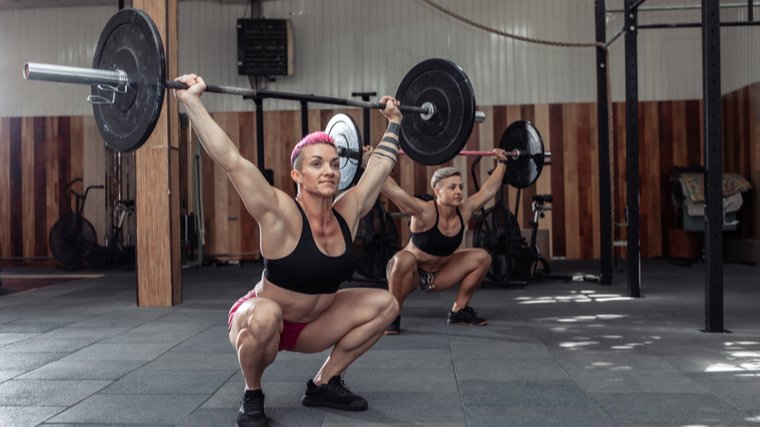
Before hopping into your first class, you may be wondering what to expect, what things you might need, and how to get through the workout. But rest assured — it’s not impossible to get started in CrossFit, even if you hate burpees and have no idea who the heck Nancy is. Keep reading to get the answers to all the questions you’ve ever had about CrossFit but were too shy to ask.
How to Find a CrossFit Gym
Starting on a new fitness journey can feel scary, but it can also be exciting. Having never done CrossFit before, you’re likely wondering how to find a gym with knowledgeable coaches, good programming, and welcoming members with an affirming community.
Ask Around
You may have driven by that CrossFit box — AKA, gym — or heard about it through a friend, but either way, you’re ready to take your first CrossFit class. One of the best ways to find a commendable CrossFit box is through referrals. Ask around to friends and family and see if anyone has insight on gyms in the area. If no one you know IRL has crossed over to the dark side, don’t be afraid to ask your friends on social media for recommendations.
Do Your Research
The next step is researching the gym itself. It doesn’t have to be that serious. Let’s be honest, you probably already checked out their Instagram page. Look at their social media and at reviews on their website and other sources like Yelp or Google. This can be a great way to get a feel for the type of community, environment, and classes at that specific gym. At the very least, you’ll want to check out the classes offered and make sure the times align with your schedule.
Community
CrossFit is notorious for creating a communal atmosphere, but not all gyms are created equal. You likely want to look for a gym that’s inclusive and affirming.
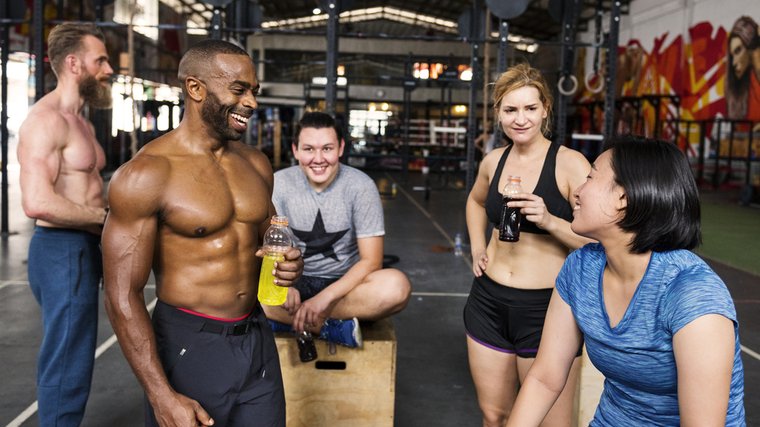
Some gyms even host activities like outdoor workouts or happy hour events for its members, if that type of thing is up your alley.
Class Structure
Some CrossFit boxes will base their classes on experience level. If you’re a beginner, they may have certain times allotted for members like you. However, many gyms have standard classes where all fitness levels are intermixed. Don’t let this intimidate you. Everyone is on their own journey, and everyone started somewhere.
Get a Guest Pass
There’s no shame in trying a couple classes at different gyms to see which environment and coaching style is best fit for you. Feeling welcome and supported by the CrossFit community can make a huge difference in your experience and motivation in the long run, and the same goes for a good coach.
Red Flags About a CrossFit Gym
You’ll want to make sure you’re looking out for big "heck no" signs from the CrossFit gyms you’re shopping around with. Keep an eye out for these red flags.
Not a Welcoming Atmosphere
If you walk into the CrossFit box for a tour or for a guest workout and you don’t feel welcomed or affirmed, it’s likely not the gym for you. Granted, sometimes nerves about trying something new can make people overly skeptical of everything about a new experience. In general, trust your gut.
The box might put out social media posts that you just don’t vibe with. Or, the gym might not offer — or isn’t willing to look into — things that you need to feel safe and comfortable. That might be anything from all-gender restrooms to consistent wheelchair access. Whatever the case, make sure that the place where you’ll be leaving it all out on the floor will bring out the welcome mat for you.
High Injury Rate
One of the biggest concerns when trying a new fitness regime is your safety. So if a CrossFit box has a record or reputation of producing a lot of injuries, that’s a red flag. It could mean that the coach doesn’t have the proper knowledge of exercises, intensity, or equipment, resulting in member injuries.
Cleanliness
Cleanliness is another factor to take into consideration. Any gym is bound to have a little wear and tear and interesting smells at busy times. You also don’t want to be covered in dirt every time you do a burpee. Not maintaining the cleanliness of a gym can be representative of the coaches and ownership, and doesn’t necessarily bode well for a box’s regard for member safety.
What Makes a Good CrossFit Coach?
One of the differences between CrossFit and a regular commercial gym is the consistent guidance from a coach. You don’t have to hire a personal CrossFit coach to work with one — they’ll likely be teaching your classes. With a personal training certificate just a test away, almost anyone has the ability to become a fitness trainer, so it’s important to understand the qualities and credentials you want to look out for.
Credentials
Unlike other gyms, to be a CrossFit coach, you need more than just a personal training certificate — you need to complete CrossFit certification courses. There are four levels of CrossFit certifications. So at the very least, your coach should be a Level One CrossFit Trainer.
Coaching Style
It’s not just the credentials that makes a good coach. A humanistic style of coaching that offers affirming inspiration, a personal relationship, and support has been shown to produce the most satisfaction. (1) Coaches that use instruction, democratic leadership styles, and positive feedback can help inspire greater group efforts. (1)
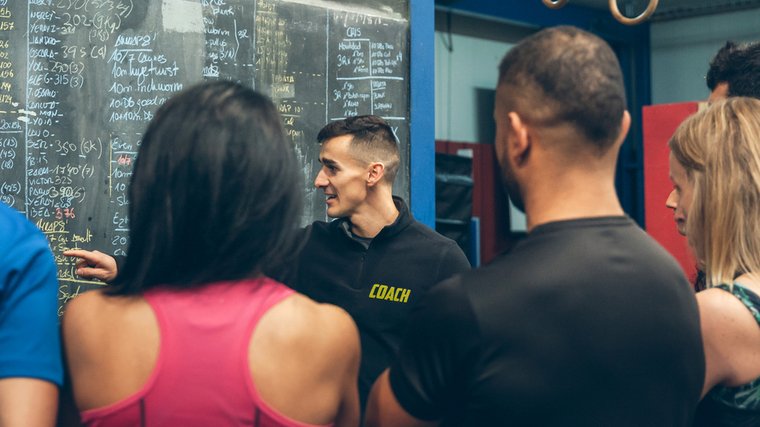
Everyone has their own coaching style that they respond best to, but qualities that make you feel supported, confident, and comfortable are generally a priority.
Teaching Style
Having the proper knowledge to teach the what’s and why’s of CrossFit can absolutely make or break an athlete. Whether you’re looking to compete or just get in shape, understanding each workout and its purpose can help you stay motivated.
A good coach doesn’t just hand you the programming — they explain the why behind the exercise. If you’ve never done a squat before, you may be wondering why you need to do one now. Explaining that it’s a functional exercise intended to improve your life outside the gym can help you love them a little bit more.
Knowledgeable About Modifications
Whether you’re a beginner or an experienced athlete with specific movement needs that may differ from other athletes in your box, find a coach that knows how to modify workouts to suit your body. If the coach doesn’t know how to help you modify movements to suit your needs or experience level, you want them to demonstrate an active desire and willingness to learn so that they can coach you most effectively.
Red Flags About a CrossFit Coach
Coaching is a surprisingly intimate business. Whether they’re your personal coach or the general gym’s coach, they’ll be the person guiding you through some of the toughest workouts of your life. You’ll want to make sure you’ve got the best guide possible.
Commitment During Class and Training
Pay attention to how invested your potential coach is while they’re coaching. Anyone can read the workout off the board, but being able to guide you through it is what makes a difference. A coach that is distracted by their phone or their lunch is one that’s likely not paying attention to you or your form. That can set you up for a nasty combination of poor motivation and higher injury risk.
Trash Talking
There’s nothing wrong with a healthy skepticism of certain workouts or even a little teasing between clients and coaches that know each other well. But a coach consistently trash talking the workout of the day can sap your motivation pretty quickly. And if that trash talk is directed at you or other members, it can do a lot more damage to morale and esteem. (1)
Poor Boundaries
Notice what kinds of relationships your potential coach has with their members. Being social and supportive is different from being flirty, suggestive, and generally demonstrating poor boundaries. Suggestive comments about your or others’ bodies can be a cause for concern, and touching clients — even to correct their form — without explicit consent isn’t something that you ever need to tolerate.
Unwillingness to Learn
It’s okay if your potential coach doesn’t know everything about what kinds of modifications you might need when you walk into a gym. But a coach who appears annoyed or hostile to the idea of doing their homework to help you access workouts is not the coach for you. The right coach will demonstrate a willingness to admit when they don’t know something and the desire to learn more to become the best version of themselves. It’s okay to pick a different coach if yours isn’t doing that for you.
CrossFit Lingo for Beginners
In your first CrossFit class, you might hear words and abbreviations that sound like gibberish. Below is a list of just some of the terminology you can expect to hear in the gym or see in the programming. There are a lot more, but these will get you started.
Box
When someone talks about their CrossFit box, you might picture a plyo box or something they’re carrying around their equipment in. And sure, plyo boxes are often a big part of CrossFit workouts. But a CrossFit box, or often just a box, is what CrossFitters tend to call their gym.
WOD
This one is pretty self-explanatory once you learn what it stands for. WOD indicates Workout of the Day. The WOD is the workout program you’ll be doing that day, often designed by the broader CrossFit engine or your specific box or coach.
Hero WODs
Hero WODs are famous workouts that honor those who have served and fallen in the line of duty. One of the most famous examples of this is Murph, which is done every Memorial Day.
Metcon
Metcon is short for metabolic conditioning. It’s a type of workout that can combine strength and cardio conditioning and is typically high-intensity. These workouts can help increase strength and conditioning performance as well as change your body composition. (2)
AMRAP
When you do an AMRAP, you’re performing as many rounds (or reps) as possible in a given time frame. It’s high in intensity as you try to complete as many rounds or reps as you can while still maintaining good form.
EMOM
Like an AMRAP, EMOMs are high-intensity workouts wrapped up in a particular time frame. EMOM stands for every minute, on the minute, meaning that you perform a prescribed number of reps of a certain exercise every minute, on the minute. It might not sound like much, but it gets pretty high-intensity — you only get to rest when you finish the prescribed rep count.
Tabata
This is a four-minute workout that involves 20 seconds of work followed by 10 seconds of rest repeated eight times. Since you’ll be working for only 20 seconds, you’ll generally go for all-out effort. But you’ll only rest for half the time you’ll be working, so suit up for an intense four minutes.
RX
You might be familiar with this one from your doctor’s office. This means you do the workout as written or prescribed. So if the workout calls for 10 deadlifts with a weight of 135 pounds for men and 105 pounds for women, doing that weight means you RX’d.
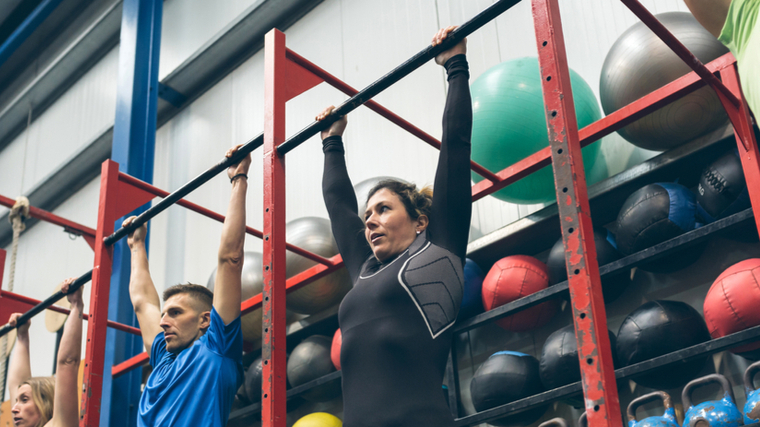
The indicated weights for men and women will be written as Deadlifts (135/105), with the first number being the weight for men and the second being the weight for women. CrossFit does allow trans athletes to compete with other members of their gender, but doesn’t have a non-gendered division or weight prescriptions at this time. If necessary, choose which weights you’re most comfortable with, or choose an in-between weight for yourself.
Scaled
When you scale a workout, you’re adjusting it to suit your needs. This might mean using lesser weight or different options, which may be due to your fitness level or an injury. So if the workout calls for 100 double unders and you do 200 singles, you scaled it (and nailed it).
Kip
When your WOD calls for a high volume of pull-ups or muscle-ups, you can incorporate kipping to add momentum and increase efficiency. Kipping is the controlled rocking motion that uses strength, coordination, and momentum to get through moves like pull-ups and toes-to-bar.
Unbroken
When you complete a full set without taking a break, you’ve done your reps unbroken. So if the workout calls for 20 wall balls, and you do all 20 in a row without stopping, you did them unbroken.
Power Clean/Snatch
Power means lifting the bar in an Olympic lift without your hips going past parallel.
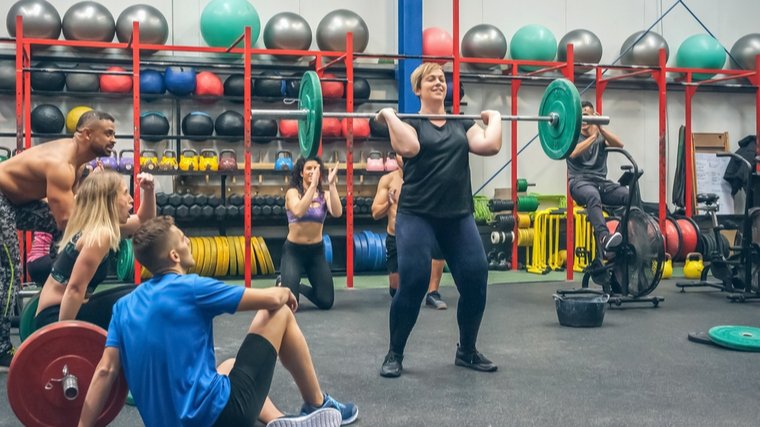
This is compared to a conventional clean or snatch where you catch the bar into a squat position, meaning you can use more weight.
CrossFit Gear for Beginners
So you signed up for a CrossFit membership, and the first class is tomorrow. There’s some gear that is essential for your first day, and other gear that can wait but is worth the investment.
Proper Footwear
Lifting shoes are a necessity because they can help provide stability to your movements and help enhance your performance more than conventional running shoes can. In fact, weightlifting shoes can help improve knee flexion and the upright position during a squat. (3)
Grips
These are especially important for the gymnastics side of CrossFit. Hand grips can help increase your grip on the pull-up bar and help prevent your hands ripping open after a long set of reps.
Foam Roller
CrossFit is notorious for leaving athletes sore because of the intense workouts and progressive overload, and seeing a massage therapist can be pricey. Foam rollers are relatively cheap and accessible. They can help reduce your soreness while helping improve your flexibility.
Weightlifting Belt
You rely on your core a lot during any type of movement, including heavy lifting. Investing in a weightlifting belt can help increase your core activation and provide some extra safety to your lifts. (4)
Knee Sleeves
Wearing knee sleeves during heavy lifts can help support your knees during heavy lifts to help prevent injuries. Since they also provide compression, knee sleeves can help boost recovery after resistance training. (5)
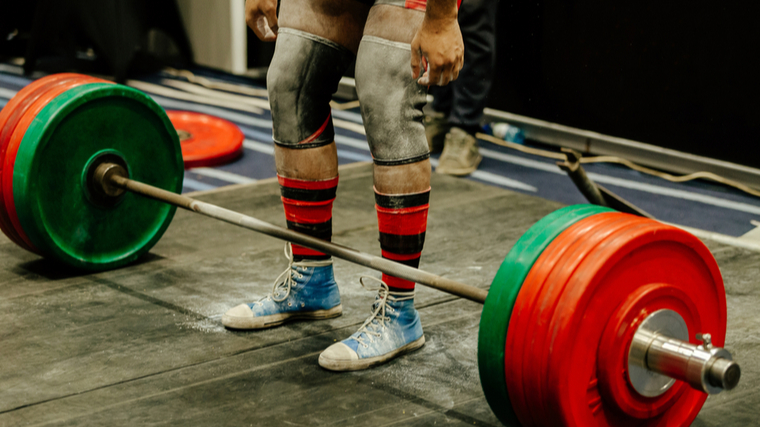
If you’re coming to CrossFit from another strength sport, you may associate knee sleeves with only the heaviest of lifts. And while CrossFitters do pull and push off some impressively heavy hefts, you’ll find that the knee sleeves (and weightlifting belts) come in handy during the high volume work characteristic of the sport. Your body will go through enough wear and tear with CrossFit — minimizing that with things like knee sleeves can help increase your longevity in the sport.
Chalk
Most boxes will have chalk on hand, but if they don’t it’s always good to have some on hand (pun intended). Chalk helps eliminate moisture from your hands, which can improve grip on barbells, dumbbells, or pull-up bars.
Getting Fit Enough for CrossFit
One of the great things about CrossFit is that anyone can do it. The exercises can be modified whether you’re a beginner or an advanced athlete. Make sure you find a coach and a box that’s supportive of WOD modifications to help you build up the strength and endurance you need to crush any workout.
Movement Pattern
Deja una respuesta

►Te puede interesar...